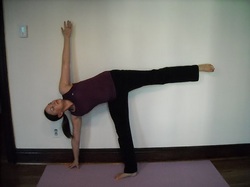
In the past, the half moon pose (Ardha Chandrasana) has been particularly challenging pose for me. I still have moments where I begin to lose my balance in the pose, yet I find myself beginning to enjoy the pose more and more. Half moon opens up my body and engages both the upper and lower half of the body.
The half moon pose is credited with alleviating anxiety, fatigue, constipation, indigestion, and backache. There are many more reasons to practice this posture during your time on the mat including strengthening your abdomen, thighs and ankles, stretching hamstrings, calves and spine, and improving coordination and balance.
There are number of ways to enter the pose such as through triangle or extended side angle. I prefer to enter the pose via triangle (Trikonasa). From triangle pose, bend the front knee. Place your hand about six inches forward of the front foot and a few inches to the outside of the foot. As you straighten through the front leg, lift the back leg off the floor until it is parallel with the ground. To open the front of the body to the side, raise the free arm in to the air until it is in line with the supporting arm and hand, which is already touching the floor.
While I am still cautious about lifting my supporting hand off the floor and rotating my head up to gaze at my raised hand, I am embracing the challenges of the posture and gaining confidence with each small accomplishment as I learn to deepen the pose.
Follow us on Facebook and Twitter. For yoga in Dunellen, NJ or yoga in Piscataway, NJ and yoga in other Central New Jersey areas, get in touch with me at Yoga Destiny.
The half moon pose is credited with alleviating anxiety, fatigue, constipation, indigestion, and backache. There are many more reasons to practice this posture during your time on the mat including strengthening your abdomen, thighs and ankles, stretching hamstrings, calves and spine, and improving coordination and balance.
There are number of ways to enter the pose such as through triangle or extended side angle. I prefer to enter the pose via triangle (Trikonasa). From triangle pose, bend the front knee. Place your hand about six inches forward of the front foot and a few inches to the outside of the foot. As you straighten through the front leg, lift the back leg off the floor until it is parallel with the ground. To open the front of the body to the side, raise the free arm in to the air until it is in line with the supporting arm and hand, which is already touching the floor.
While I am still cautious about lifting my supporting hand off the floor and rotating my head up to gaze at my raised hand, I am embracing the challenges of the posture and gaining confidence with each small accomplishment as I learn to deepen the pose.
Follow us on Facebook and Twitter. For yoga in Dunellen, NJ or yoga in Piscataway, NJ and yoga in other Central New Jersey areas, get in touch with me at Yoga Destiny.

